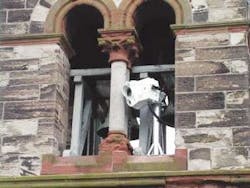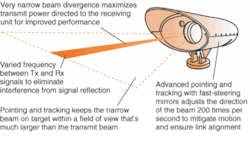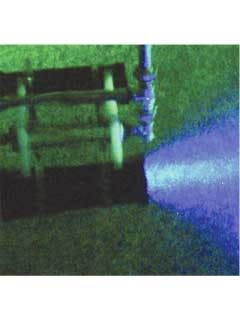Free-space optics builds invisible bridges
The push for better broadband access and tighter network security is creating new opportunities for FSO technologies in metro and wireless applications.
Developed in the 1960s for military and aerospace applications, free-space optical communications (also known as free-space optics, or FSO) has had limited success in the commercial sector. Potential users have had a hard time overcoming the perception that technical issues—primarily range limitations and atmospheric interruptions such as fog—make FSO unreliable or overly expensive. In addition, the telecommunications downturn of the last few years prompted several major carriers, especially in the United States, to shelve plans to add FSO technologies to their network offerings.
But this scenario is changing. The technology has matured, safety standards are in place, and FSO installations worldwide are on the rise.1 While FSO systems have established themselves in enterprise applications such as university campuses, hospitals, and law firms, the push for greater broadband access by consumers and better network security for government applications is spurring broader adoption of free-space communications. Traditional wired systems connecting buildings to telephone and cable systems do not have the capacity necessary for bandwidth-intensive applications, and local-access fiberoptic bridges to fiber backbones are often too expensive ($100,000 to $500,000 per mile) to install.
Free-space optics, on the other hand, offers several unique advantages that are attracting the attention of customers and paving the way for new applications outside of the campus-enterprise niche (see Fig. 1). Free-space technology requires no spectrum licensing, is easily upgradeable, and its open interfaces support equipment from a variety of vendors. Installations take only days to complete, versus six to 12 months to bury new fiberoptic cables. In addition, vendors say that FSO systems have been shown to be both reliable and price-competitive when compared to fiber systems. Typical costs for individual FSO links are $10,000 to $20,000 for enterprise applications and $20,000 to $50,000 for carrier-class installations.
The Strategis Group (Washington, D.C.) expects sales of FSO equipment to grow from $120 million in 2000 to more than $2 billion annually by 2006. In the past year, FSO providers such as Canon USA (Lake Success, NY), Terabeam (Redmond, WA), LightPointe (San Diego, CA), and fSONA (Vancouver, B.C., Canada) have announced product deployments in applications ranging from The Great Wall Broadband Network in Beijing, China (Terabeam) to the New York State Unified Court System (Canon).2 In addition, newly cost-conscious wireline carriers such as AT&T, Verizon Communications, and SBC Communications are evaluating FSO systems as a lower-cost fiber alternative technology for linking local customers to their long-distance networks. Other recent FSO "wins" include:
- The Office of Homeland Security and Public Safety has deployed the Terabeam Elliptica system in its network in New Orleans and seven surrounding parishes to protect critical infrastructure and to ensure communications during heightened periods of national security or in the event of a natural disaster or emergency. "The system was truly put to the test during a recent tropical storm," said Terry Ebbert, director of the Office of Homeland Security and Public Safety in New Orleans. "While parts of the city were flooded, the Terabeam system stayed operational throughout the entire storm."
- LightPointe, which claims more than 1000 installations worldwide, formed a strategic partnership agreement with Huawei Technologies Co., China's leading telecommunications equipment provider, to manufacture FSO products for the China market under the Huawei brand. LightPointe has similar relationships with telecom providers in South Africa, the United Kingdom, and Japan.
- Dominion Lasercom (Bryan, TX) deployed a 29-link 200-Mbit/s FSO metro Ethernet network with the Weslaco Independent School District in South Texas. "We were able to build our new network for a fraction of the cost of a fiber ring and cheaper per megabit than any other broadband technology," said Jeff Harris, IT director for Weslaco ISD.
- fSONA signed a partnership agreement with Netware Technologies to provide its SONAbeam family of FSO products. Netware caters to the prime carriers in India, Europe, and Far/Middle eastern markets; Netware's first project was to deploy SONAbeams for the touchtel division of Bharti Enterprises.
"Fundamentally, FSO is a technology that is here to stay," said John Schuster, chief technology officer at Terabeam. "It offers too many advantages in terms of data rate, bandwidth, and seamless connectivity with fiber."
Multibeam vs. multimode
Using many of the same components used in fiber-based networks, free-space communications involves the optical transmission of voice, video, and data through the air—or, in some cases, underwater (see "FSO finds niche under the sea," p. 71). It is a line-of-sight technology that uses invisible laser beams (typically 850 or 1550 nm) for the optical bandwidth connections. Each FSO unit comprises an optical transceiver with a laser transmitter, a receiver, and proprietary pointing and tracking systems. After being emitted by the laser, the optical pulses are focused by a lens and sent out as a collimated beam of light that disperses with distance (approximately 40 cm/km). When the transmitted photons reach the aperture lens of the receiver, they are focused onto a photodetector that converts the pulses into an electrical signal. The receiver then amplifies and regenerates the electronic signal, completing the data-transfer link.
In many ways, the technology behind a typical FSO system has become relatively standardized. Most systems use off-the-shelf low-power IR lasers, primarily because the standards regulating eye safety of these systems limit their power output—and, unfortunately, their range. Current FSO systems are capable of transmitting data at rates up to 2.5 Gbit/s over distances of several kilometers—more than enough for most broadband applications. Many FSO hardware manufacturers use 785- or 850-nm light because the components necessary to support these wavelengths are relatively inexpensive. Others use 1550-nm lasers, which are more expensive but allow for higher power levels and, therefore, greater link availabilities and link ranges (but also require auto-tracking to maintain beam alignment). To resolve the range and reliability issue, FSO systems can be designed with limited link lengths as part of an interconnected optical mesh that extends broadband service to many buildings that might otherwise be too far away to be reached by a single FSO link.
Other potential limitations of FSO—fog, rain, snow, sandstorms, birds, trees, and building sway—have been debated for years and at this point are well understood. LightPointe and fSONA, for example, use a multibeam approach that they say overcomes atmospheric and reliability issues (see Fig. 2). The LightPointe family of flight optical-transport equipment uses either 850- or 1550-nm lasers to provide dedicated bandwidth ranging from 10 Mbit/s to 2.5 Gbit/s. According to Gerald Clark, vice president of engineering, using four redundant vertical-cavity surface-emitting lasers improves system reliability; when combined with signal spacing that allows independent parallel beams to be summed at the receiver, the system overcomes atmospheric turbulence effects and improves bit-error-rate performance. In addition, the company collects and analyzes weather data and link performance from installations around the globe to provide customers with the tools needed to deploy metro data networks, cellular backhaul with FSO links, and other applications with predictability.
Similarly, the SONAbeam product line from fSONA ("free-space optical network architecture") features redundant 1550-nm diode lasers transmitting 50 to 4600 m (160 ft to 2.9 miles) with link availabilities (uptime consistency) in the 99.999% range. According to Robert Carlson, chief technology officer of fSONA, each laser in a four-laser system emits 160 mW of power, making it one of the most robust systems on the market. In addition, he says, the multilaser approach helps overcome "atmospheric scintillation"—the fog issue.
"We have put much emphasis on ruggedness and the ability to handle high temperature ranges," said Michael Penner, vice president of corporate development for fSONA. "One of our key market segments is defense, which plays very strongly on the high data rate and ruggedness of our systems."
The Terabeam Elliptica FSO transceiver, on the other hand, uses a single-laser (1550 nm) multimode approach that the company says ensures highly available and reliable wireless links with a mean time-between-failure of more than 60,000 hours (see Fig. 3). The Elliptica achieves narrow-beam transmission using pointing and tracking and fast-steering mirrors, which makes it possible to gain the benefits of using highly directional narrow-beam transmission to direct more power on the intended receiver, while adjusting for severe motion conditions. According to the company, the Elliptica system can adjust and direct the narrow-beam transmission within an area that is 35 times larger than the actual beam width.
"FSO has the challenge of being very easy to do on a clear day and very hard to do on a foggy day," Schuster said. "We build systems to work on a foggy day. FSO range has to be combined with availability—that is, what is the probability of the system going down during a weather event? And fog is the biggest limitation."
Looking ahead
At this point, the FSO community is educating potential customers about the benefits of this technology and dispelling concerns about its robustness and reliability in adverse conditions. As bandwidth demands increase and investment in new fiber installations is harder to get, interest increases in FSO as an alternative. Other emerging applications include:
- Cellular backhaul. Many FSO suppliers report "substantial interest" in their technology as an alternative to T1 and E1 lines in data-intensive wireless backhaul—that is, improving mobile wireless networks with extensions and relief of backhaul from cell towers to high-bandwidth fiber.
- Wi-Fi hotspots. According to fSONA, FSO is conducive to providing Wi-Fi backup; Wi-Fi and FSO work well together because free-space optics produces no interference. The company is designing combination Wi-Fi and FSO systems to mitigate interference and improve hot-spot performance.3
- Digital video transport for cable TV networks.
- Disaster recovery and redundant links for fiber-network backup.
"All of the things we are doing as a society are driving bandwidth demands," said Jeff Bean, director of marketing and communications for LightPointe. "Fiber is great, but FSO can do the same things, and people are starting to implement these things in tandem."
REFERENCE
- A. Acampora, Scientific American (June 17, 2002).
- S. Hardy, Lightwave (July 2003).
- S. Marek, Wireless Week (Feb. 1, 2003).
FSO finds niche under the sea
Free-space optical (FSO) communications can face a number of atmospheric challenges (most notably fog), but the potential obstacles become even more daunting when you take the technology underwater. There may be no birds or trees, but there are fish and phytoplankton and numerous other potential interruptions floating about. In addition, even the clearest water has 1000 times the signal attenuation of clear air, while turbid water has more than 100 times the attenuation of dense fog.
But there are compelling reasons to pursue the development of FSO technologies that can be used under the sea, and the U.S. Department of Defense in particular is investing in these technologies. Current undersea communications—radio and acoustic—are very limited, propagating poorly in sea water or offering very slow data rates (about 2400 bits/s, less than a typical end-user Internet connection).
"There simply is no technology available for doing high-bandwidth communications underwater without a contact system," said Phil Lacovara, founder and president of Ambalux (Tucson, AZ). "Low bandwidth is done routinely with acoustic systems, but there are a number of situations in which it is difficult or undesirable to have a contact system with an object underwater."
Since being founded in 2000, Ambalux has been developing proprietary FSO technology that specifically addresses this need. Working primarily in the 450- to 550-nm range, the company has developed techniques for building very high-power blue-green LED arrays that offer maximum transmission capabilities underwater (see figure). The company also has focused on pointing and tracking capabilities specifically for installations that are not fixed—say, between an unmanned underwater vehicle and a fixed transceiver.
"We have developed a free-space transceiver set that allows 10 Mbit/s full duplex communication between two fully submerged platforms," Lacovara said. "We also have some patent-pending technology that allows us to extend the data rate even in very highly scattering conditions up to 100 Mbit/s."
With the current emphasis on homeland security, potential applications include port inspection and hull inspection. "We are trying to provide some marriage between what is going on above the water and what is going on below the water," he said.




